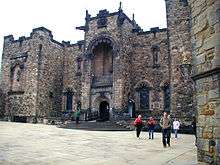Scottish National War Memorial
The Scottish National War Memorial is located in Edinburgh Castle and commemorates Scottish soldiers, and those serving with Scottish regiments, who died in the two world wars and more recent conflicts. The monument was formally opened in 1927. It is housed in a redeveloped barrack block in Crown Square, at the heart of the castle, and incorporates numerous monuments.

Development
Proposals for a Scottish National War Memorial were put forward in 1917, during the First World War, by John Stewart-Murray, 8th Duke of Atholl, and Capt George Swinton of Kimmerghame. Sir Robert Lorimer, one of the architects involved in the Imperial War Graves Commission,[1] was appointed in 1919, but opposition to a large-scale monument arose from the Cockburn Association and others concerned with the castle's heritage. A more modest scheme to remodel the North Barrack Block was finally agreed in 1923, and the memorial was formally opened on 14 July 1927 by the Prince of Wales.[2] After the Second World War 50,000 names were added to the rolls of honour. Names continue to be added from successive conflicts, however the memorial itself has been left unchanged.[2]
The Memorial
The exterior of the building is decorated with gargoyles and sculpture by Pilkington Jackson, John Marshall[3] and Phyllis Bone,[4] whilst the interior contains elaborate wall monuments commemorating individual regiments. The stained-glass windows are by Douglas Strachan.[5] The original aim behind the Memorial was to commemorate Scots and those serving with Scottish regiments who had died in the First World War, from the declaration of war on 4 August 1914 to the Treaty of Versailles of 28 June 1919 (confirmed military suicides and those tried and executed excepted). Upon the altar within the Shrine, placed on the highest part of the Castle Rock emerging through the floor, stands a sealed casket containing the Rolls of Honour listing over 147,000 names of those soldiers killed in the First World War together with open lists within the Hall.[6] After the Second World War the limiting dates were modified, with another 50,000 names inscribed on the Rolls of Honour within the Hall, and with further names continuing to be added there.[2] The memorial is maintained by a charitable trust known as the Scottish National War Memorial.[7]
References
- Hussey, 1931; Dictionary of National Biography, 1937
- Henderson, Diana M. "History of the Scottish National War Memorial". Scottish National War Memorial. Archived from the original on 18 July 2011. Retrieved 19 March 2011.
- "John Marshall (1888–1952)". Glasgow Sculpture. Retrieved 22 June 2018.
- "Phyllis Bone's Sculptures". The Natural History Collections. The University of Edinburgh. Retrieved 16 November 2017.
- McWilliam et al, pp.99–100
- "Scottish National War Memorial". UK National Inventory of War Memorials. Retrieved 3 May 2011.
- "Scottish National War Memorial, SC009869". Scottish Charity Register. Office of the Scottish Charity Regulator. Retrieved 25 July 2011.
Sources
- McWilliam, Colin; Gifford, John; Walker, David (1984). Edinburgh. The Buildings of Scotland. Penguin. ISBN 9780140710687.
External links

- Scottish National War Memorial website